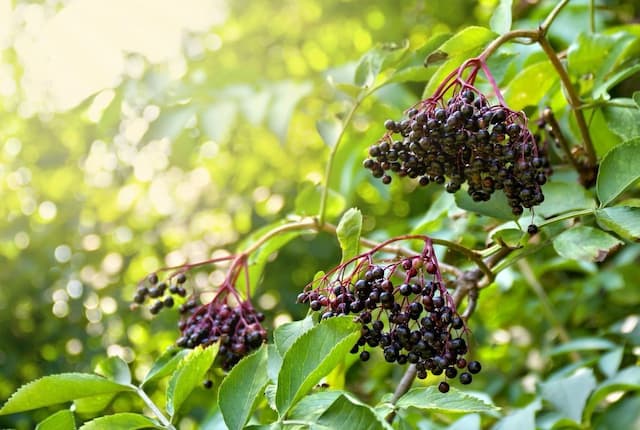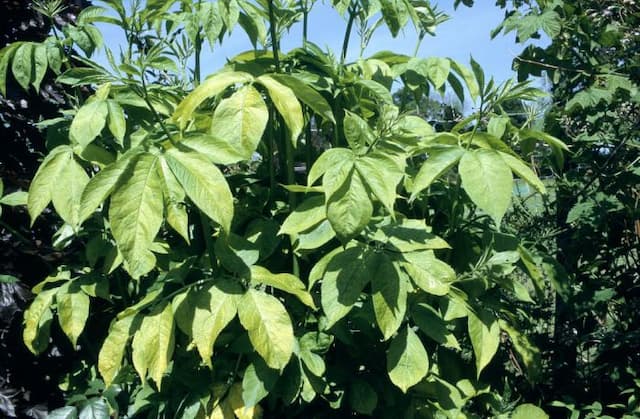Doublefile Viburnum Viburnum plicatum f. plicatum 'Rosace'

ABOUT
The plant commonly known as Doublefile Viburnum 'Rosace' is noted for its distinctively layered horizontal branching pattern, which gives it a striking appearance throughout the year. In spring, this plant transforms with showy, lace-cap flowers that have a unique composition; small fertile flowers are in the center surrounded by larger sterile flowers, creating a pinwheel-like effect. These blossoms are often a snowy white, making them stand out against the backdrop of the plant's medium to dark green leaves. The leaves themselves have a pleated texture, adding depth and visual interest to the foliage. As the seasons change, the white flowers give way to reddish-black fruit that can attract birds and wildlife to the garden. In autumn, the leaves typically change to a reddish-purple, creating a vibrant display before they fall off for the winter. The berry-like fruits can linger on the shrub, providing a touch of color even as the temperatures drop. The Doublefile Viburnum 'Rosace' is appreciated for its symmetrical form, offering a balanced look without the need for regular pruning. This variety of Viburnum is a deciduous shrub, meaning that it sheds its leaves annually, revealing the bare framework of branches that await the return of spring to be adorned in greenery once more.
About this plant
 Names
NamesSynonyms
Japanese Snowball, Doublefile Viburnum, Japanese Snowball Bush
Common names
Viburnum plicatum f. tomentosum 'Rosace'.
 Toxicity
ToxicityTo humans
Japanese Snowball 'Rosace' is not commonly known to be toxic to humans. While it is generally considered safe, if any part of the plant is ingested in significant quantities, it could potentially cause mild stomach upset due to the presence of saponins and other compounds. However, incidents and symptoms of poisoning are rare, and the plant is usually not a concern for human toxicity.
To pets
Japanese Snowball 'Rosace' is also not commonly known to be toxic to pets. Just as with humans, significant ingestion could potentially cause mild stomach upset in animals such as cats and dogs, but the plant is not widely recognized for having potent toxins that affect pets. Therefore, it is not typically considered a serious threat, but it's always prudent to prevent pets from eating ornamental plants since individual sensitivity may vary.
 Characteristics
CharacteristicsLife cycle
Perennials
Foliage type
Deciduous
Color of leaves
Green
Flower color
White
Height
8-10 feet (2.4-3 meters)
Spread
6-8 feet (1.8-2.4 meters)
Plant type
Shrub
Hardiness zones
5
Native area
Japan
Benefits
 General Benefits
General Benefits- Landscape ornamentation: The Japanese Snowball, as it is commonly known, is widely appreciated for its ornamental value thanks to its elegant layered branches and striking, spherical, white flower clusters.
- Wildlife attraction: The plant offers nectar and habitat to a variety of pollinating insects, including bees and butterflies, and its berries can attract birds.
- Seasonal interest: This plant provides year-round visual interest with its white flowers in spring, green foliage turning reddish-purple in fall, and textured bark in winter.
- Privacy screen: Due to its dense growing habit, it can be used as a privacy hedge for homeowners looking to create a natural fence.
- Low maintenance: The Japanese Snowball is generally easy to care for once established, requiring minimal pruning and being relatively resistant to pests and diseases.
- Erosion control: With its well-developed root system, it can help stabilize soil on slopes and prevent erosion.
 Medical Properties
Medical PropertiesThis plant is not used for medical purposes.
 Air-purifying Qualities
Air-purifying QualitiesThis plant is not specifically known for air purifying qualities.
 Other Uses
Other Uses- Dye production: The bark of the Japanese snowball can be used to create a natural dye for textiles, offering a range of colors depending on the mordant used.
- Insect repellent: Crushed leaves may release a scent that can deter certain insects, providing a natural repellent option for gardens.
- Photography: The intricate beauty of the Japanese snowball's flowers and structure make it a popular subject for botanical photographers and artists.
- Culinary decoration: While not edible, the blooms can be used for ornamental purposes to decorate plates or serving trays during special occasions.
- Craft materials: Dried flowers and branches can be used in floral arrangements, wreaths, and other crafts for their shape and durability.
- Soil erosion control: The robust root system of the Japanese snowball can help stabilize soil on slopes and prevent erosion.
- Privacy screening: When planted in a row or as a hedge, this plant can serve as a natural privacy screen due to its dense foliage.
- Aquarium decoration: After proper treatment to ensure they are safe for aquatic life, branches can be placed in aquariums as part of the habitat decor.
- Educational tool: This plant can be used in schools or educational programs to teach about plant identification, cultivation, and horticultural practices.
- Sound barrier: The thick foliage and dense growth habit can help absorb noise, making it useful as a natural sound barrier in urban environments.
Interesting Facts
 Feng Shui
Feng ShuiThe plant Japanese Snowball is not used in Feng Shui practice.
 Zodiac Sign Compitability
Zodiac Sign CompitabilityThe plant Japanese Snowball is not used in astrology practice.
 Plant Symbolism
Plant Symbolism- Renewal and New Beginnings: The lush flowers of the Japanese Snowball, which is typically what Viburnum plicatum is known for, symbolize spring and the renewal of life, hinting at fresh starts and new opportunities.
- Innocence and Purity: The Japanese Snowball's white, delicate flowers suggest purity and innocence, often associated with the unblemished beauty of nature.
- Bridal Connotations: With its showy, rounded blooms, the Japanese Snowball is sometimes associated with weddings and can symbolize the purity and new beginnings that a marriage hopes to bring.
- Beauty and Elegance: The striking appearance and graceful form of the Japanese Snowball's blooms convey a message of refined beauty and poise, appreciated in various cultures for its aesthetic splendor.
 Water
WaterThe Japanese Snowball Viburnum requires consistent moisture and should be watered deeply once a week, with about 1 to 1.5 gallons per session for an established plant, depending on the soil conditions and climate. During the hot summer months or in particularly dry weather conditions, increase the frequency to twice a week to ensure the soil remains moist but not waterlogged. It's crucial to avoid overwatering as this can lead to root rot.
 Light
LightThe Japanese Snowball Viburnum thrives in full sun to partial shade. The ideal spot for this plant is one where it receives at least four hours of direct sunlight a day, but is also protected from the intense late afternoon sun. Placing it in an area with morning sun and dappled afternoon shade can help encourage robust growth and flowering.
 Temperature
TemperatureThe Japanese Snowball Viburnum can survive within a temperature range from -10 to 30 degrees Fahrenheit, but it grows best in climates where the average temperature is between 60 and 70 degrees. It is cold hardy and can withstand winter temperatures down to -10 degrees without significant damage, but should be protected from extreme heat above 95 degrees.
 Pruning
PruningPrune the Japanese Snowball Viburnum after flowering to maintain shape and encourage healthy growth. It's typically pruned once a year, immediately after its spring bloom to enhance the display for the next season. Lightly thinning out the oldest branches every few years will help rejuvenate the plant and allow for better air circulation and light penetration.
 Cleaning
CleaningAs needed
 Soil
SoilThe best soil mix for the Japanese Snowball 'Rosace' should be well-draining, rich in organic matter, and maintain a slightly acidic to neutral pH of around 5.5 to 7.0. A mix of garden soil, compost, and peat moss can achieve these conditions, ensuring good fertility and moisture retention.
 Repotting
RepottingJapanese Snowball 'Rosace' typically does not require frequent repotting and can be done every 3-5 years or when the plant outgrows its current container. Careful root pruning may be necessary during repotting to maintain plant health.
 Humidity & Misting
Humidity & MistingThe Japanese Snowball 'Rosace' prefers average humidity levels consistent with most outdoor garden environments. While specific humidity levels aren't critical, the plant does best with natural, ambient humidity typically found in outdoor settings.
 Suitable locations
Suitable locationsIndoor
Provide bright indirect light and adequate space for growth.
Outdoor
Plant in partial shade, ensure soil drains well, water regularly.
Hardiness zone
5-8 USDA
 Life cycle
Life cycleViburnum plicatum f. plicatum 'Rosace', commonly known as Doublefile Viburnum, starts its life cycle when a seed germinates in the soil, typically in the spring following a period of cold stratification which breaks seed dormancy. Seedlings develop roots and shoots, gradually maturing into young plants with characteristic layered branches. As the shrub grows, it enters a vegetative stage where leaves expand and develop the distinctive pleated appearance; this stage is followed by the development of flower buds in late winter. Blooming occurs in spring, showcasing the plant's white lace-cap style flowers that attract pollinators. After pollination, the flowers give way to red berry-like drupes that mature to black, providing food for wildlife and completing the reproductive cycle. Throughout its lifespan, which can extend several decades, the Doublefile Viburnum undergoes annual cycles of growth, flowering, and senescence, with periods of dormancy during the winter.
 Propogation
PropogationPropogation time
Spring-Early Summer
The most popular method for propagating the Japanese Snowball, Viburnum plicatum f. plicatum 'Rosace', is through softwood cuttings. This is typically done in late spring or early summer when the plant's new growth is just beginning to mature and the stems are still flexible. To propagate, one should cut a 4 to 6 inch (10 to 15 cm) length from the end of a healthy branch, making sure that there are at least two sets of leaves on the cutting. The lower set of leaves should be removed, and the cut end can be dipped in rooting hormone powder to encourage root development. The cutting should then be planted in a pot filled with a mixture of peat and perlite, covering the bottom nodes where the leaves were removed. The pot should be kept moist and in a warm, indirect light until roots have established, which can take several weeks. Once rooted, the new plant can be transplanted into the garden or a larger pot for further growth.




![Elder [Black Tower]](/_next/image?url=https%3A%2F%2Fplants-admin.emdemapps.com%2Fimages%2Fplants%2F%2Fimages%2F604b5cad99578.png&w=640&q=75)




